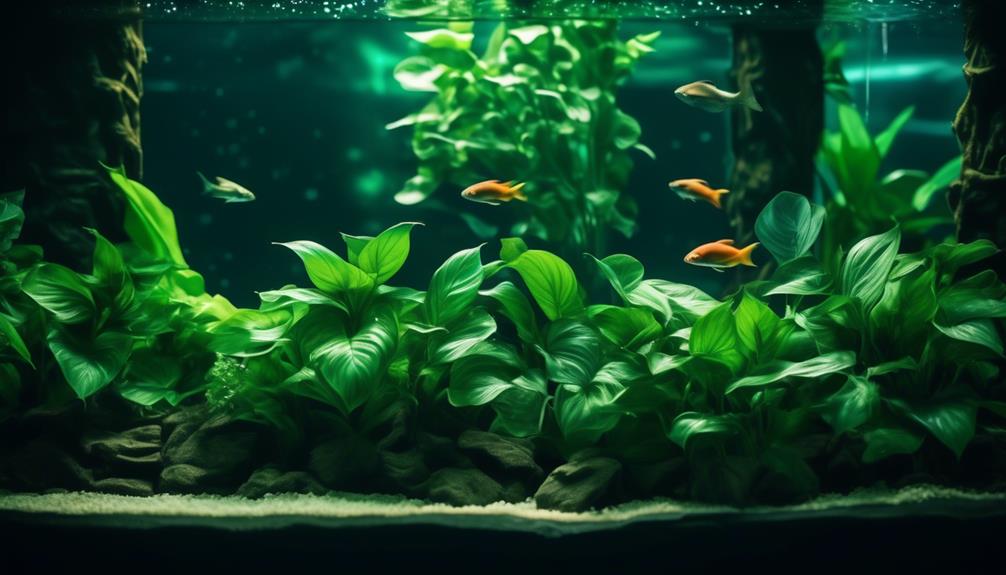Aquarium enthusiasts are constantly seeking innovative ways to enhance the beauty and functionality of their aquatic habitats. One method that has been gaining attention is the incorporation of pothos, a versatile and resilient houseplant, into aquariums.
This intriguing plant not only adds a touch of greenery to the underwater landscape but also serves as a natural filtration system, reducing the need for traditional methods. But how exactly does pothos achieve this? And what are the best techniques for placement and maintenance?
In this discussion, we will delve into the transformative power of pothos in aquariums, offering valuable insights and practical tips to help you create a vibrant and thriving aquatic ecosystem.
Key Takeaways
- Pothos is a hardy houseplant that can survive in low light conditions, making it suitable for aquariums.
- It is toxic to cats and dogs if ingested, but aquarium fish do not seem to have any issues.
- Pothos can be easily found at local hardware stores or plant nurseries, and small pots are sufficient as it grows quickly.
- Using pothos in aquariums provides natural filtration, helps control nitrate levels and algae growth, and creates a visually appealing underwater jungle.
Benefits of Using Pothos in Aquariums
Using Pothos in aquariums provides numerous benefits for both the aquatic environment and the fish inhabitants. When comparing Pothos with other aquatic plants, Pothos stands out as a hardy and adaptable option.
Unlike many other aquatic plants, Pothos can thrive in low light conditions, making it suitable for aquariums with limited lighting setups. Additionally, Pothos has a significant impact on aquarium water chemistry. It acts as a natural filtration alternative, helping to control nitrate levels and reduce algae growth.
The long, stringy roots of Pothos create a visually appealing underwater jungle and provide a natural habitat for fish to swim and hide in. Regular trimming of dense roots can be done to maintain aesthetics.
Proper Placement and Maintenance of Pothos
To ensure optimal placement and maintenance of Pothos in your aquarium, careful consideration must be given to its positioning and ongoing care. Here are three important factors to keep in mind:
- Proper placement: If using a hang-on-back filter, it is advisable to place the Pothos away from the motor compartment to prevent any interference. Additionally, Pothos can grow into long vines that can be guided to climb walls or shelves, providing a visually appealing underwater jungle.
- Trimming techniques: Regular trimming of dense roots is essential to maintain aesthetics and prevent overcrowding. Trimming the roots can be done by cutting off any excess growth. These cuttings can also be propagated in other tanks, allowing you to expand the presence of Pothos in your aquarium.
- Alternative filtration options: Pothos serves as an affordable alternative filtration option for aquariums. Its long, stringy roots provide excellent biological filtration, helping to keep nitrate levels and algae growth under control. By regularly trimming the roots and maintaining the Pothos, you can ensure its effectiveness as a natural filtration system.
Using Pothos as Natural Filtration

Can Pothos be used as a natural filtration system in aquariums?
Using Pothos in hydroponic systems is a popular method for maintaining water quality. Pothos has the ability to absorb nitrates and other nutrients from the water, effectively reducing their levels and preventing algae growth. This plant's roots release oxygen into the water, improving the overall oxygenation of the aquarium. Additionally, Pothos can help stabilize pH levels by removing excess carbon dioxide.
When using Pothos in aquariums, it is important to consider its effects on water chemistry. Pothos can alter the pH of the water slightly, making it more alkaline. Regular monitoring of water parameters is necessary to ensure a healthy environment for the fish.
Finding and Planting Pothos in Aquariums
Pothos, with its ability to naturally filter water and maintain water quality, can be easily incorporated into aquariums through the process of finding and planting the plant. Here are three important steps to consider for proper plant selection, care, and maintenance:
- Plant selection: Look for healthy pothos plants at local hardware stores or plant nurseries. Opt for small pots as pothos grows rapidly, especially in aquariums with heavy bioloads. Starting with a plantlet that already has established roots will promote faster growth.
- Care and maintenance: Before planting, make sure to thoroughly wash off any dirt and fertilizer from the roots to maintain water chemistry. Depending on fish behavior, you can either plant the pothos in a hang-on-back filter or directly in the tank. If using a filter, place the pothos away from the motor compartment. Trimming the roots may be necessary in the future.
- Plant placement: Pothos can grow into long vines that can be guided to climb walls or shelves, creating a visually appealing underwater jungle. The long roots also create a natural habitat for fish to swim and hide in. Additionally, cuttings from the pothos can be propagated in other tanks, allowing you to expand its benefits throughout your aquarium setup.
Additional Information and Resources

For further information and resources regarding the use of pothos in aquariums, there are various online platforms and downloadable materials available to assist aquarium enthusiasts in optimizing their aquatic environments.
Those interested in the benefits of pothos in hydroponic systems can explore specialized forums and websites dedicated to hydroponics and aquaponics. These platforms provide in-depth discussions, expert advice, and step-by-step guides on incorporating pothos into hydroponic setups.
Additionally, there are downloadable materials such as e-books and PDF guides that offer comprehensive information on how to propagate pothos cuttings. These resources provide detailed instructions on selecting healthy cuttings, preparing them for propagation, and nurturing them into thriving plants.
Frequently Asked Questions
Can I Use Pothos in Saltwater Aquariums?
Pothos is not recommended for use in saltwater aquariums due to its preference for freshwater conditions. It thrives in freshwater aquariums and provides benefits such as natural filtration and aesthetic appeal.
How Often Do I Need to Trim the Roots of the Pothos Plant?
The frequency of trimming the roots of the pothos plant in an aquarium depends on its growth rate and desired aesthetics. Regular trimming promotes plant health and prevents overgrowth, while the benefits of pothos in aquariums include natural filtration and a visually appealing underwater environment.
Can Pothos Survive in High Light Conditions?
Pothos (Epipremnum aureum) can survive in high light conditions, making it suitable for aquariums with bright lighting. However, it is important to monitor the health of the plant and provide proper care, including regular watering and pruning to maintain optimal growth.
Are There Any Other Plants That Can Provide Similar Filtration Benefits as Pothos?
Spider plants (Chlorophytum comosum) can also provide similar filtration benefits as pothos in aquariums. They are known for their air-purifying properties and can help control nitrate levels and algae growth, while adding visual appeal to the tank.
Can I Use Pothos as a Standalone Filtration System in My Aquarium?
Pothos can be used as a standalone filtration system in aquariums to eliminate algae. Its benefits extend to aquaponics systems by providing excellent biological filtration and controlling nitrate levels.
Conclusion
In conclusion, incorporating pothos in aquariums offers numerous benefits including enhanced water quality, visually appealing underwater environments, and cost-effective natural filtration.
The fast growth and ability of pothos to absorb excess nitrates make it an effective alternative to traditional filtration methods.
By following proper placement and maintenance techniques, aquarium enthusiasts can harness the power of pothos to transform their aquariums into vibrant and thriving ecosystems.
An interesting statistic to note is that pothos can remove up to 80% of nitrates from aquarium water, significantly improving water quality for fish and other aquatic organisms.

